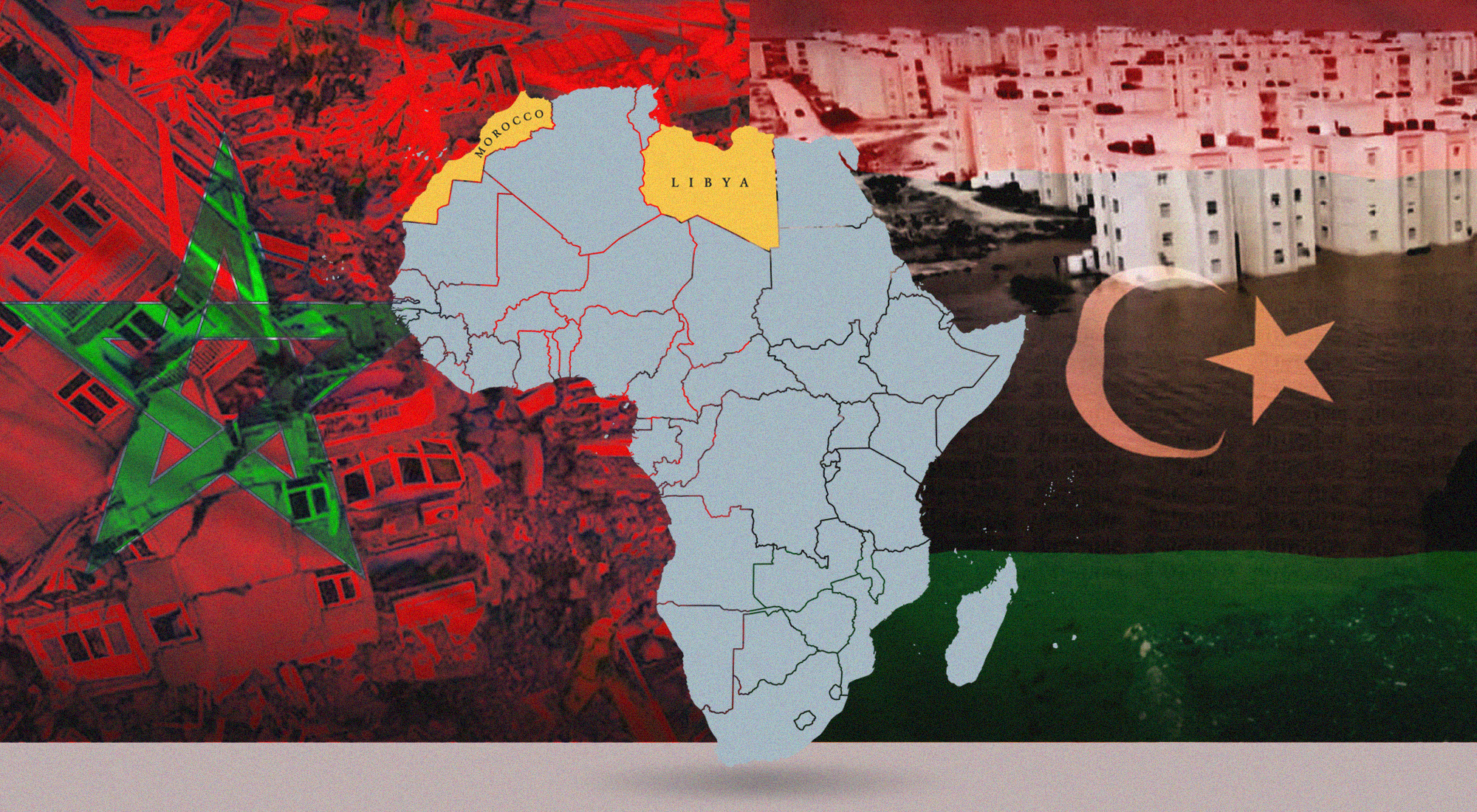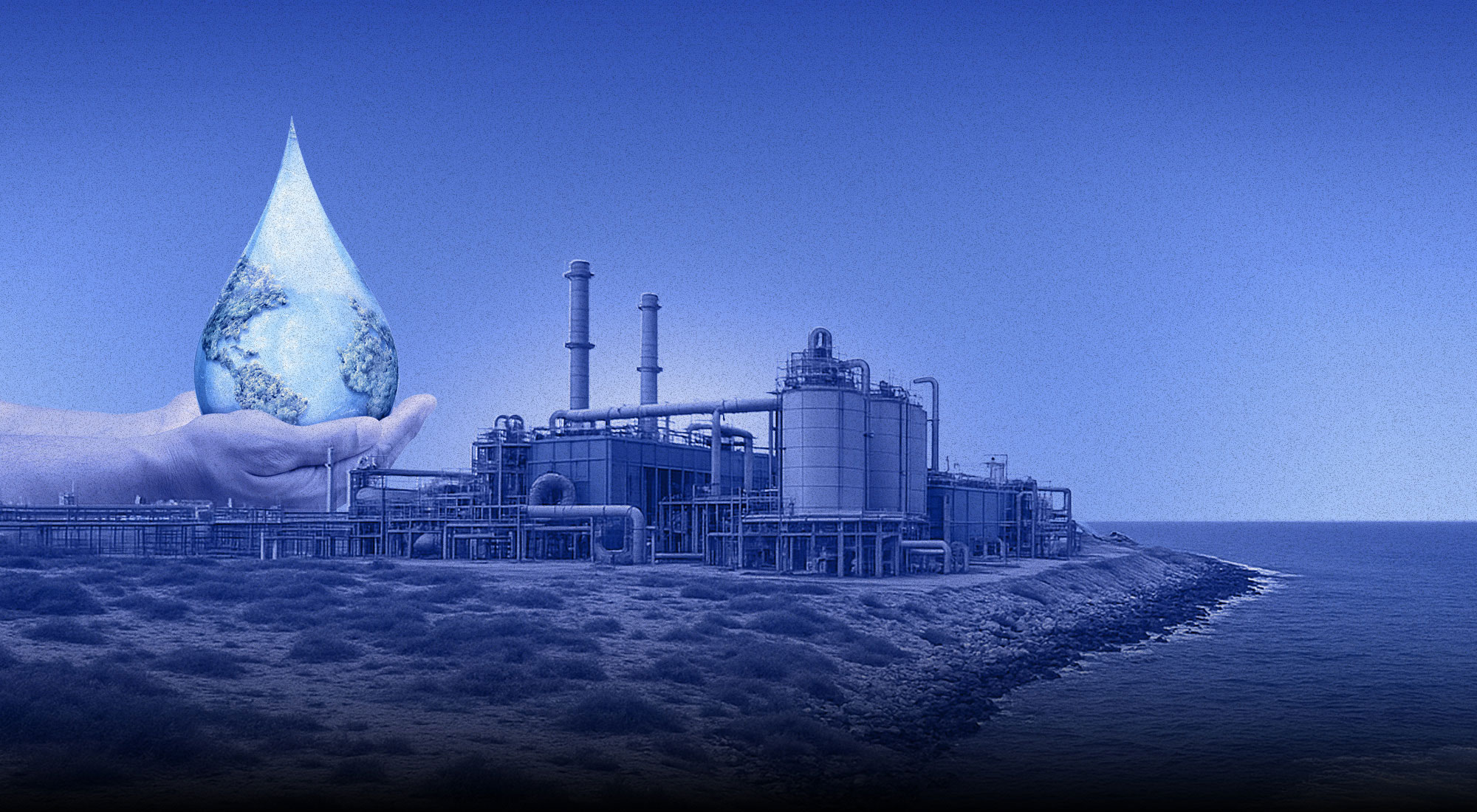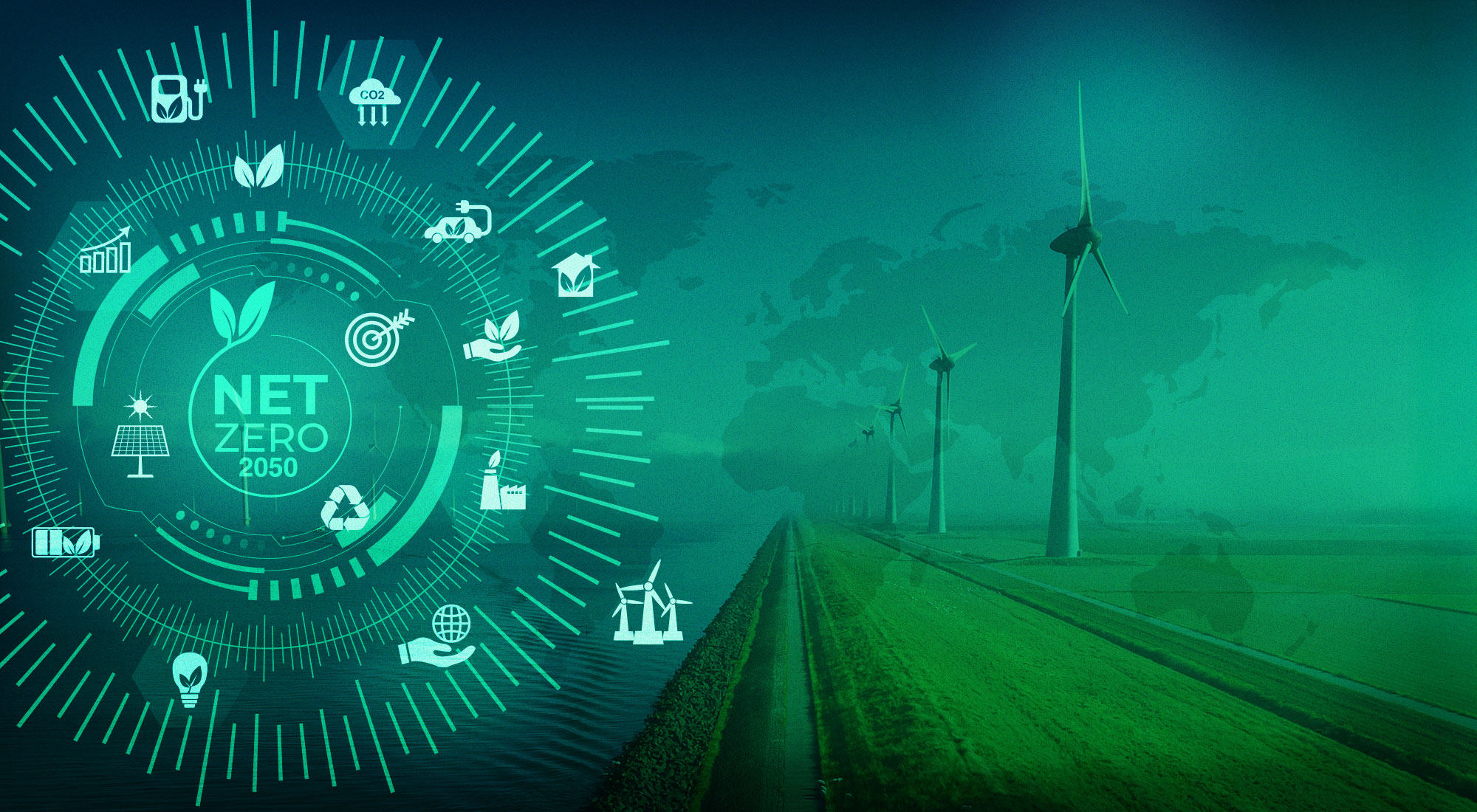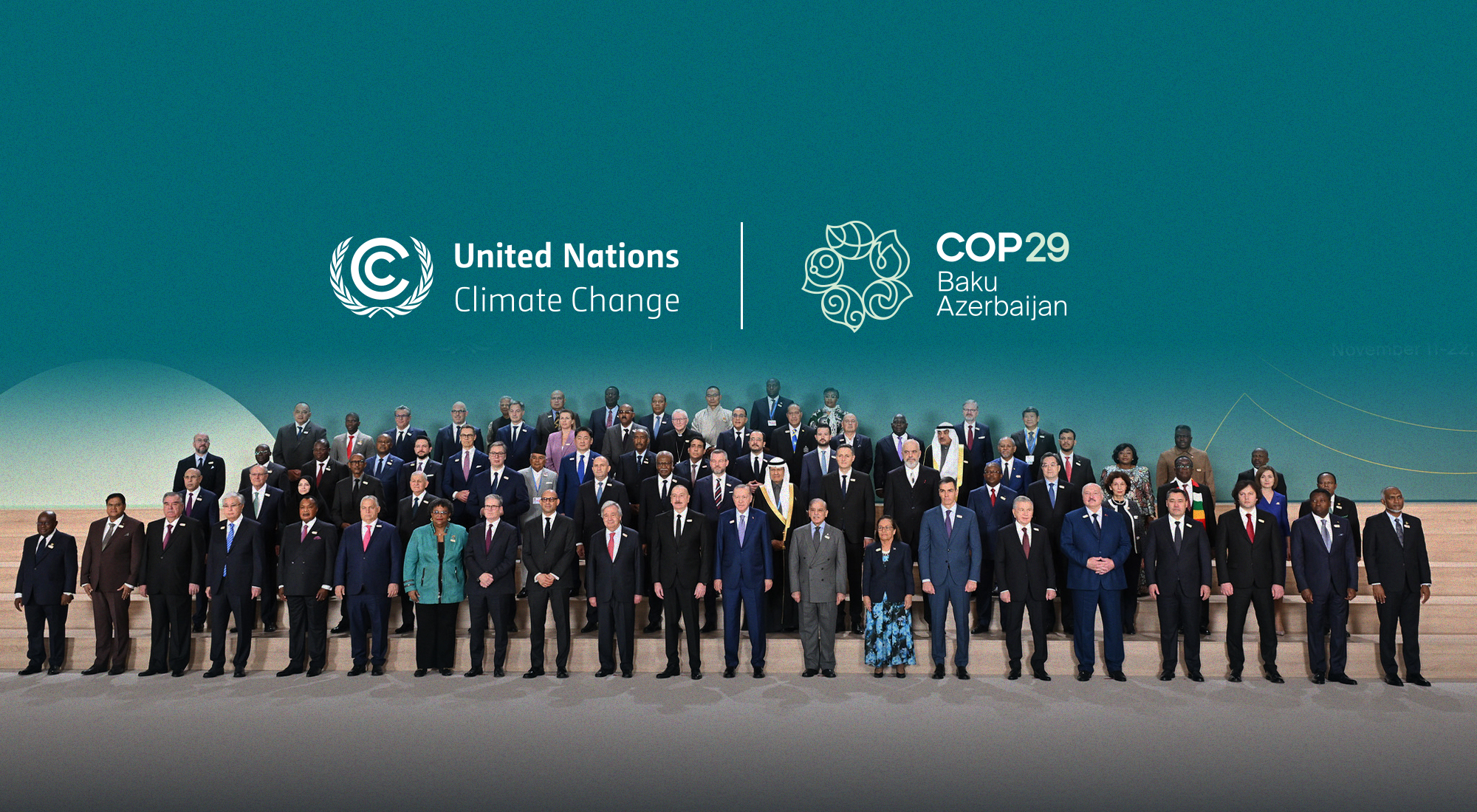Source: Fadel Senna/AFP, and Ahmed Elumami /Reuters
North Africa has always been a strategically important region due to its location between three continents.[1] With vast oil reserves, important trade ports, and its favorable position overlooking the Mediterranean Sea, the region has become the epicenter of some of the most important geopolitical dynamics of the last decades, from the migration crisis in Europe to the Islamist insurgency in the Sahel, all the way down to the recent unrest in West Africa.[2] The recent earthquakes and flooding have exacerbated an already precarious power balance, besides affecting the lives of millions of people, with entire cities devastated.[3] But these events have had a deeper impact beyond the humanitarian crisis, resulting in a change in the security dynamics of the region and affecting European foreign policy in Africa, which will likely lead to a drastic change in inter-regional dynamics.
The main question that this paper addresses is how these earthquakes have affected security and geopolitics in North Africa, based on the regional security complex theory (RSCT) developed by the Copenhagen School of International Security Studies. This theory emphasizes that geopolitical dynamics at the regional level should be seen as interdependent and functioning like regional clusters driven mainly by geographic proximity. Security is viewed as a socially constructed concept shaped by the perceptions, interests, and interactions of actors in each region.[4] This is closely related to constructivism, which emphasizes the importance of social constructions and ideational factors in shaping the behavior and interactions of states and other actors in the international system.[5] The interactions among states in the regional security complex create an interdependence of security that occurs within a geographically coherent grouping. This paper will also make reference to a modified version of the regional security complex theory called the “securitization model”, which can help understand the complex web of connections between affected countries and how events affect those connections. Overall, this paper will highlight the significance of comprehending how abstract concepts affect security and how geographic proximity affects regional interactions.[6]
To tackle the research question using this approach, the paper has been structured into four parts. The first part will analyze the natural disasters in Morocco and Libya and their role in exposing structural flaws linked to governance, and public policy. The second part examines how North Africa’s physical geography and position has determined its role as an echo chamber for the spillover effect, exploring its links with the surrounding regions. The third part analyzes the links between North Africa and its surroundings and how they determined the recent uprisings in West Africa and the migration crisis in Europe. The fourth part examines the effects of the earthquake in Morocco and the risks for European foreign policy in North Africa.
Drawing upon the RSC Theory, this research developed a specific approach for this geographical area that analyzes and determines a pattern in the relationship between geography and security concerning the Sahara Desert, the Mediterranean, and their role in regional dynamics.
The paper concludes that the absence of a holistic approach to security that considers multi-level dynamics, along with the lack of a standardized and unified European approach to cooperation, contributes to the structural weaknesses of North African governments. This, in turn, increases instability, hindering any initiative aimed at resolving the migration crisis and containing the recent burst of instability in West Africa and the Sahel. The recent earthquakes and flooding have revealed how this one-sided approach significantly contributes to the region’s instability and lack of preparedness for crises, amplifying regional dynamics such as the migration crisis and the Jihadist insurgency in the Sahel.
The Twin Catastrophes: From Morocco’s Earthquake to Libya’s Flooding
In September 2023, North Africa was struck by two major natural disasters, considered by some analysts to be some of the most devastating in recorded history.[7] Firstly, on 8 September 2023, a magnitude 6.8 earthquake struck at 11:11 PM west of the town of Oukaïmedene in western Morocco.[8] Its destructive force was reported to have claimed the lives of more than 2,900 people and injured another 5,500. The earthquake heavily damaged parts of the ancient section of Marrakech and devastated several remote settlements in the Atlas Mountains. Its tremors were felt as far away as Morocco’s largest city, Casablanca, and in Portugal and Algeria.[9] The Moroccan government immediately dispatched ambulances, rescue teams, and military personnel to the area to support emergency response operations. Alongside the central government, many humanitarian organizations rushed to aid the affected population, including the World Central Kitchen, Doctors Without Borders, GlobalGiving. Additionally, other countries such as Spain, Qatar, the UK, and the United Arab Emirates offered their assistance.[10] But according to humanitarian organizations, the government has not issued a widespread plea for aid and has only accepted restricted foreign assistance.[11] Although aid swiftly arrived in the main urban centers like Marrakech, emergency response efforts faced difficulties reaching many isolated villages located in the rugged Atlas Mountain range. Many urban centers and villages have experienced a partial or complete lack of humanitarian aid, which has caused distress among some survivors who lack basic humanitarian support, along with a sense of abandonment.[12] According to analysts, the main reason for the slow response to the earthquake in Morocco is the centralized decision-making structure.[13] A dynamic that has been previously explored in a previous paper on the Turkish-Syrian earthquake, and which once again appears to be a common denominator in the slowness and inefficiency of emergency response is a primary structural weakness that needs to be addressed, since this directly affects perceived security and, therefore, stability.[14]
Source: ERCC – Emergency Response Coordination Centre / European Commission
More than 850 miles to the east, on the night of 10 September 2023, after Storm Daniel, the deadliest Mediterranean tropical-like cyclone in recorded history, reached the coasts of Libya. With winds exceeding 70 mph and heavy rainfall of over 150 mm, it appeared to have caused the Mansur dam, located at the convergence of two river valleys, to collapse.[15] The released waters rushed seven miles towards the sea and overwhelmed the Derna dam, which was also under stress from rising water levels in its reservoir.[16] This led to a devastating and deadly torrent that swept through Derna. Entire neighborhoods were believed to have been washed away, and the city was declared a disaster zone. This led to the deaths of over 11,300 people.[17] Some reports suggested that the death toll could rise to over 5,000. The flooding displaced over 43,000 people, making it the worst disaster of 2023.[18]
However, various reports suggest that the catastrophe didn’t solely result from the forces of nature but also due to the lack of maintenance of the dam and negligence, which is suspected to have started as early as 2012. In 2007, Arsel Construction Company was contracted by Muammar Gaddafi, the then ruler of Libya, to carry out maintenance on two dams and construct a third one. The company’s website claimed that the work began in 2007 and was scheduled to be completed in 2012. Nevertheless, the project was prematurely terminated because the company failed to provide the contracted budgets for the project, according to Abdul Hamid al-Dbaiba, the prime minister of the Tripoli-based Libyan government that competes with the administration in Libya’s east, where Derna is located.[19] The company left Libya in 2011 during the revolt against Muammar Gaddafi, and neither dam was ever repaired, according to a government assessment dated 2012.[20] As a result, neither of the existing dams received the necessary repairs, and the promised third dam was never built.[21]
Despite the almost decade-long political unrest and the humanitarian crisis caused by the storm, Libya’s vital oil industry has remained surprisingly steady, providing the local government with the necessary revenue to keep operating and maintain sovereignty. As demonstrated by the recent announcement from the National Oil Corporation (NOC), owned by the government in Benghazi, it plans to launch an oil and gas licensing round in 2024. This initiative is expected to support the national goal of producing over 2 million barrels per day (bpd) of oil within the next three years. However, this resilience is being tested as the country grapples with the aftermath of this historic storm.[22] The catastrophe fostered an uncommon sense of solidarity, prompting government agencies nationwide to swiftly mobilize to assist the afflicted regions. Although the eastern Libyan government based in Tobruk spearheaded the relief initiatives, the western government situated in Tripoli allocated approximately US$412 million for reconstruction efforts in Derna and other eastern towns. Additionally, an armed group in Tripoli dispatched a humanitarian aid convoy to contribute to the relief efforts.[23] From this, it is possible to see how Storm Daniel has indeed played an inevitable role in the humanitarian disaster in Derna, but it was just one of the main factors, once again demonstrating the intricate connection between security, structural weaknesses, and natural disasters.
The Geographical Paradox: North Africa as a superconductor
The region of North Africa has historically served as a crossroads and a boundary between civilizations. The Trans-Saharan Trade Routes played a significant role in the spread of Islam throughout many regions of sub-Saharan Africa. These trade routes connected West Africa to the Islamic world, particularly the Middle East, and facilitated the exchange of goods, ideas, and technologies between these regions. The spread of Islam in ancient Africa was largely peaceful and gradual, occurring through merchants, traders, scholars, and missionaries. African rulers either accepted the religion or converted to it themselves. In this manner, Islam spread across and around the Sahara Desert. Conversely, North Africa was perceived by various European powers as marking the “end of the Mediterranean Corridor”. The Roman Empire considered North Africa as a boundary between their empire and the rest of the world. This perception was also shared by other European powers, such as the Spanish Empire and Portuguese Empire later.
This perception is intricately linked to the physical geography of the region. In the north, the Mediterranean, as an open body of water, serves as a direct link to Europe. The apparent lack of physical barriers and the relative ease with which a boat can navigate through it have determined its role as an accelerator of dynamics. This is especially evident when we consider historically the role of the Mediterranean as central to commerce and trade in the region, linking different ports, cities, and empires. Nowadays, those same routes are also used by human traffickers who take advantage of the proximity to the European coastline to continue organizing trips for migrants towards Europe.[24]
Edwin Lax / TRENDS Research & Advisory
If we shift our focus south, we will see how the Sahara also plays a crucial role in the relationships amongst regional security complexes.[25] A century ago, the influence of events between the Sub-Saharan African regional complex and the North Africa Regional Complex was limited by geographical limitations. However, in the contemporary era marked by advancements in transportation technologies, geography no longer necessarily represents an obstacle to human mobility but rather serves as an obstacle to state sovereignty, limiting its pervasive force in relation to human activities, and in this specific case, to illegal activities.[26] It simultaneously weakens state control while acting as a direct link between regions, thus becoming a superconductor of instability.
This perception of weakened state authority, dictated by geography, underscores the complex relationship between geographical factors, human behavior, and government instability.[27] An example of this is the Islamist Insurgency in the Sahel, a direct consequence of the Libyan Civil War, which has created the necessary power vacuum to allow the influx of armament to the Tuareg regions of southern Libya. This prompted a shift in the power balance and a lack of perceived state authority, which provided local militias enough reason to demand independence and autonomy from the government in Tripoli.[28] A lack of perceived state authority quickly spread to the other side of the border, where we witnessed the rise of Ansar Dine, an Islamist group that has been battling the Malian government since 2012, and which, from 2017, merged into the Jama’at Nasr al-Islam wal Muslimin, active in various parts of West Africa, including Burkina Faso, Algeria, and Niger.[29] From this, we can observe how a destabilizing input from the North African regional security complex has been multiplied thanks to the social and geographical characteristics of the Sahara region, creating instability in at least four neighboring countries. In the evolving geopolitical landscape, the Mediterranean and Sahara Desert have transitioned from being geographical insulators and mere links to powerful multipliers of regional dynamics. This transformation has exponentially heightened the spillover effects between cluster regions.[30]
The pattern of Instability: From the unrest in West Africa to the Migration Crisis in Europe
As mentioned above, the peculiar position of North Africa and its geographical conformation have determined its role as a superconductor of dynamics. However, the spillover effect has had a looming impact, reaching several countries in West Africa where the unrest is occurring, well beyond the Sahara Desert.[31] Firstly, we need to analyze the elements that have contributed to the vulnerability of these countries. The first of these is the relationship between state sovereignty and the central government. As noted by Daniel Baltoi in his article on the West Africa wave of unrest, an emblematic case is that of the Ex-President of Guinea, Alpha Condé, who pursued an increasingly authoritarian path, including the prohibition of protests and the curbing of media freedom. Authoritarian tendencies have been justified as necessary measures to confront the increased activity of Jihadist groups in the Northern provinces. Similarly, Kaboré’s government in Burkina Faso used the insurgency as a pretext to limit citizens’ freedom of expression and assembly. Consequently, it is not surprising that Burkinabé society did not strongly mobilize against the unrest and has little faith in its democratic institutions. Security crises are “fertile ground” for uprisings, according to Malian sociologist Aly Tounkara, as does the “lack of integrity of leaders.” The two countries are now said to be the primary source of violence in their region, locked into a dangerous self-perpetuating instability. Across the sparsely populated, poorly policed Sahel, weak local governance creates gaps for Jihadist movements to fill, which further weakens local governance—and lends legitimacy to plotters of uprisings.[32]
Therefore, we see the existence of common structural elements in West African countries that make them especially susceptible to the spillover effect caused by the geographic conformity of the region. It is necessary to understand that the perceived threat of Jihadist groups in the north has worked as justification for the pursuit of internal interests by factions within the central government, which has propelled an authoritarian spiral, causing a perceived imbalance and thus a lack of legitimacy among the local population and parts of the government. This lack of legitimacy has been, in most cases, utilized by the military to retain power and establish a new internal order, as we have seen with the recent case of Niger. Meanwhile, local militias and Jihadist groups continued to take advantage of this instability to increase their influence in the region, which ultimately spread and affected more and more countries sharing similar characteristics to the ones mentioned above, triggering what is defined as a “democratic blackout” of local governments. This explains why the international effort for the stabilization of the most vulnerable ECOWAS countries cannot limit itself to military support but should also focus on the promotion of internal policies that prevent an imbalance in the internal political equilibrium, which is the root cause of the recent wave of uprisings in West Africa. This wave, where the Sahara has acted as a multiplier of the instability dynamic carried out by local militias and Jihadist groups, has served as a fuse for chaos and instability in the region.[33]
Source: Topographic-map.com (Left), and Frankfurter Allgemeine Zeitung (Right)
Now that the link between physical geography, the uprisings in West Africa, and the Jihadist insurgency in the Sahel are analyzed, the elements to understand the background of the migration crisis that has significantly affected Europe in recent months are conspicuous. The reports of constant arrivals of migrants on the Italian island of Lampedusa and the border crossings in Spanish regions of Melilla and Ceuta are just the result of a dynamic rooted in two intertwined levels, the military/strategic one and the political one.[34] The regional instability driven by sovereignty gaps in the Sahel has also affected the already vulnerable regional economy, which has grown primarily due to population growth itself. However, on a per capita basis, it has been a modest 1.3 percent, as analyzed by the Brookings Institute. The stagnant economy was also caused by languishing foreign investment.[35] The state of the economy, however, is the direct consequence of structural vulnerabilities and insecurity linked to the previously mentioned “democratic blackout.” In this context, we can see how the internet has functioned as fuel for the dissatisfaction of African youth. By comparing their living conditions and situation to the perceived prosperity in the West and other rich countries, they have developed a sense of frustration and a desire to become part of a prosperity they believe awaits them beyond their own world.[36] The local demand for an escape has triggered the establishment of illegal migration routes that utilize the physical geography and the lack of stability to reach the shores of North Africa and, ultimately, Europe. In this, North Africa has been both the cause and the consequence of these dynamics. Firstly, the Libyan Civil War prompted a first wave of instability in the Sahel, which then spread to different countries, including Algeria, Mali, Guinea, Burkina Faso, and their neighbors.[37] This has led to several “Democratic Blackouts,” further fueling the economic and migration crises. In this context, recent natural disasters have become catalysts for further instability. The perceived lack of state sovereignty and effectiveness could give rise to other extremist groups to take advantage of the situation and link themselves to the various actors propelling instability in the Sahel. Specifically, the Atlas Mountains and the Libyan Desert are geographically vulnerable areas for national sovereignty.[38] If coupled with the recent case of Tunisia, where there is an internal lack of political equilibrium and economic crises that also shares concerning similarities with what has happened in several West African countries, we can see that there are several critical spots that could lead to an expansion of the stability crisis and, therefore, the migration crisis. This is something that will inevitably also affect Europe.[39]
The Weaknesses of European Foreign Policy and Their Effects on Regional Security
The recent events in Morocco and Libya have not only highlighted the links between instability clusters in the regions and the structural weaknesses of the local governments but have also underscored the complex relationship with Europe. The European Investment Bank (EIB) has pledged €1 billion over the next three years to Morocco’s post-earthquake reconstruction program, which aims to mobilize €12 billion by 2028.[40] In Libya, it has been providing emergency aid through the Civil Protection Mechanism and humanitarian funds since the beginning of the disaster. The EU Civil Protection Mechanism was activated on 12 September 2023, to provide support to Libya. Several EU countries have offered substantial assistance through the Civil Protection Mechanism. To date, 10 member states have stepped up to the challenge. The EU has also deployed humanitarian experts to assess people’s needs beyond the city of Derna, as well as environmental experts to work with the United Nations Disaster Assessment and Coordination (UNDAC) team operating on the ground.[41] These examples demonstrate the proactive approach of the European Union and its generally cooperative relationship with North African countries. What is interesting, though, are the tensions and misunderstandings that have arisen with individual European countries. A prominent example of this is the controversy surrounding French aid to Morocco.[42]
Despite Rabat receiving help from Spain, Britain, Qatar, and the United Arab Emirates, it seems that no aid request has reached Paris. Both governments have been quick to dismiss any allegations of tensions between them, but this unusual situation has raised many eyebrows, nonetheless. As pointed out by Politico, relations between France and Morocco have been strained for several months over issues related to visas for Moroccan nationals, along with the issue of the recognition of Western Sahara and relations with Algeria, which seem to be other points of possible tensions between the two governments.[43] This shows that, on the one hand, the involvement of the European Union in the region is not necessarily in line with the diplomatic relations of individual European countries. On the other hand, future initiatives in the region could be hampered by involvement in regional politics.
Any security and economic initiative in the area relies on both the stability of the local governments and their cooperation. As we have seen in the recent French withdrawal from Niger, the risk of escalation and the loss of a geopolitical presence in the region is a very real and direct threat to the influence and capabilities of European governments to counter the jihadist insurgency and the illegal migration flow towards Europe.[44] This, in large part, would be a grave strategic loss for NATO, possibly leading to further instability, and reshaping the global power balance. We can then see how a refusal of aid could harm local governments, leading to an increase in instability, which would be detrimental to both North African and European governments. Once again, we see the previously mentioned paradigm of the “Security Blackout,” as seen in West Africa, repeating itself on the other side of the Sahara, and this time expressed in the form of tangled foreign relations. The fate of North African countries is closely linked to that of Europe. It is, therefore, necessary that individual European countries act with caution when involving themselves in local politics and instead focus on a more integrated European approach to foreign relations in the region. This is not to say that France or any European country lacks the ability to manage individual diplomatic relationships, but that there is a very high risk that one miscalculated move from one country has the potential to impact all other European and African countries as well.[45]
In summary, the recent seismic events in Morocco and flooding in Libya have profoundly reshaped the landscape of North African regional security. These natural disasters unearthed vulnerabilities linked to governance, geographical factors, and public policies.[46] Although the earthquakes could have exacerbated already existing tensions and instability in the region, they also offered opportunities for improved cooperation and collaboration following the disaster. These events underscore the intricate interdependencies among countries in the region and the pressing need for unified responses to shared challenges and crises.
The repercussions of these seismic events are poised to have widespread ramifications, influencing both African nations and Europe. The intricate relationship between geography, security, and regional interactions has been laid bare, highlighting the need for a comprehensive security strategy in the region, and establishing North Africa as a superconductor of dynamics. The absence of such an approach, coupled with the lack of a standardized and harmonized European cooperation strategy, has contributed to the inherent weaknesses of North African governments, intensifying instability and impeding efforts to address the migration crisis and mitigate the upsurge of instability in West Africa and the Sahel. The recent events have highlighted the vulnerabilities in the relationship between Europe and North Africa, as well as the complexities of individual European countries’ involvement in the region. The fate of North African countries is closely linked to that of Europe, emphasizing the need for careful diplomatic relations and a more integrated European approach to foreign policy in the region. In the coming months, the region is likely to witness a dramatic change in its dynamics, stemming from the earthquakes and their aftermath.[47] The intricate connections between geography, security, and governance will continue to shape the future of North Africa, and the region’s ability to maintain its sovereignty will be tested in the face of the new challenges posed by the ever-changing global scenario with the war in Ukraine, and the recent crisis in Gaza.
[1] NATO, “The Strategic Foresight Analysis (SFA) Regional Perspectives Report on North Africa and the Sahel,” 2023,
[2] Jakub Grygiel, “The Importance of the Mediterranean Sea,” Hoover Institution, January 10, 2020, https://www.hoover.org/research/importance-mediterranean-sea.
[3] Urooba Jamal, “Middle East Roundup: Disaster in North Africa – Morocco quake, Libya floods,” Al Jazeera, September 14, 2023,
[4] Buzan Barry, Ole Wæver, and Jaap de Wilde, Security: A New Framework for Analysis (Boulder: Lynne Rienner Publishers, 1997).
[5] Michael C. Williams, “Words, Images, Enemies: Securitization and International Politics,” International Studies Quarterly 47, no. 4 (2003): p. 511, https://www.jstor.org/stable/3693634.
[6] Buzan Barry, Ole Wæver, and Jaap de Wilde, op. cit.
[7] Abdulkader Assad, “Yale University: Storm Daniel is the deadliest in recorded African history,” The Libya Observer, September 17, 2023, https://libyaobserver.ly/news/yale-university-storm-daniel-deadliest-recorded-african-history.
[8] Greg, G., “Morocco Earthquake,” International Amateur Radio Union, September 9, 2023,
https://www.iaru-r1.org/2023/morocco-earthquake-8-september-2023/.
[9] John P. Rafferty, “Morocco earthquake of 2023,”Britannica, September 13, 2023,
https://www.britannica.com/event/Morocco-earthquake-of-2023.
[10] “Morocco earthquake: Why authorities accepted limited foreign aid,” Al Jazeera, September 12, 2023,
[11] “What to know about the Morocco earthquake and the efforts to help,” ABC News, September 11, 2023, https://abcnews.go.com/International/wireStory/morocco-earthquake-efforts-103077713.
[12] “Photos: Survivors question rescue efforts after Morocco’s earthquake,” Al Jazeera, September 12, 2023, https://www.aljazeera.com/gallery/2023/9/12/photos-survivors-question-rescue-efforts-after-moroccos-earthquake.
[13] Claire Parker, “How rigid government, state neglect hobbled Morocco’s earthquake response,” The Washington Post, September 12, 2023, https://www.washingtonpost.com/world/2023/09/12/morocco-earthquake-response-aid-government/.
[14] Edwin Lax, “The Turkish-Syrian earthquakes and their impact on regional security in the Middle East,” TRENDS Research & Advisory, August 9, 2023, https://trendsresearch.org/research.php?id=606&title=The_Turkish-Syrian_earthquakes_and_their_impact_on_regional_security_in_the_Middle_East.
[15] Maziar Motamedi, “Why did Derna’s dams break when Storm Daniel hit Libya?,” Al Jazeera, September 13, 2023, https://www.aljazeera.com/news/2023/9/13/why-did-dernas-dams-break-when-storm-daniel-hit-libya.
[16] Faye Hulton, “Weather tracker: Libya floods caused by Storm Daniel ‘medicane,’ The Guardian, September 15, 2023, https://www.theguardian.com/environment/2023/sep/15/weather-tracker-libya-floods-storm-daniel-medicane#:~:text=By%20Saturday%2010%20September%2C%20Daniel,widely%20recorded%20in%20the%20region.
[17] “Libya floods: death toll in Derna surges past 11,300, with 891 buildings destroyed,” South China Morning Post, September 17, 2023, https://www.scmp.com/news/world/africa/article/3234824/aid-arrives-flood-hit-libya-hopes-fade-survivors.
[18] “Libya flood disaster displaced over 43,000 people, says UN migration body,” France 24, September 21, 2023, https://www.france24.com/en/live-news/20230921-libya-flood-disaster-displaced-over-43-000-people-iom.
[19] Soylu, R., “Derna Turkish firm said repaired dam, did it? Middle East Eye,” 2023, Retrieved from https://www.middleeasteye.net/news/libya-floods-derna-turkish-firm-said-repaired-dam-did-it.
[20] Niamh Lynch, “Libya floods: Experts warned about Derna dams for nearly 40 years, state prosecutor says,” Sky News, September 18, 2023, https://news.sky.com/story/libya-floods-experts-warned-about-derna-dams-for-nearly-40-years-state-prosecutor-says-12964391.
[21] “Libya Flooding Disaster Underlines the Country’s Corruption,” The New York Times, September 27, 2023, https://www.nytimes.com/2023/09/27/world/middleeast/libya-flooding-derna-corruption.html.
[22] Felicity Bradstock, “Libya’s Oil And Gas Rebound At Risk After Historic Storm,” OilPrice.com, September 22, 2023, https://oilprice.com/Energy/Crude-Oil/Libyas-Oil-And-Gas-Rebound-At-Risk-After-Historic-Storm.html.
[23] “Flooding death toll climbs to staggering 11,300 in Libya’s coastal city of Derna, aid group says,” PBS News Hour, September 14, 2023, https://www.pbs.org/newshour/world/flooding-death-toll-climbs-to-staggering-11300-in-libyas-coastal-city-of-derna-aid-group-says#:~:text=While%20the%20Tobruk%2Dbased%20government,a%20convoy%20with%20humanitarian%20aid.
[24] Ghislaine Lydon, On Trans-Saharan Trails Islamic Law, Trade Networks, and Cross-Cultural Exchange in Nineteenth-Century Western Africa, (Cambridge University Press, 2012), https://assets.cambridge.org/97805218/87243/frontmatter/9780521887243_frontmatter.pdf.
[25] Dr. Stephen Burgess, “Regional Security Complexes and African Foreign Policies,” Journal of Indo-Pacific Affairs, Special Issue, November 2021,
https://media.defense.gov/2021/Nov/17/2002894844/-1/-1/1/JIPA%20-%20BURGESS%20-%20AFRICA.PDF.
[26] Lebanese Armed Forces, “Globalization And the Challenges to State Sovereignty and Security,” Lebanese National Defense, no. 52, April 2005,
https://www.lebarmy.gov.lb/en/content/globalization-and-challenges-state-sovereignty-and-security.
[27] El Moussaoui El Ajlaoui, “Security Challenges and Issues in the Sahelo-Saharan Region,” Friedrich-Ebert-Stiftung, Bamako Office, 2016, https://library.fes.de/pdf-files/bueros/fes-pscc/14022.pdf.
[28] “Shifts in the Libyan Civil War,” Africa Center for Strategic Studies, June 16, 2020, https://africacenter.org/spotlight/shifts-libya-civil-war/.
[29] Transnational Threats Project, “Jama’at Nasr al-Islam wal Muslimin (JNIM),” Center for Strategic and International Studies, 2018,
https://www.csis.org/programs/transnational-threats-project/jamaat-nasr-al-islam-wal-muslimin-jnim.
[30] An Atlas of the Sahara-Sahel: Geography, Economics and Security, West African Studies (Paris: OECD Publishing, 2014), https://doi.org/10.1787/9789264222359-en.
[31] Adam Dastrup, Introduction to World Regional Geography, PRESSBOOKS, 2019,
[32] Daniel Baltoi, “A Deeper Look Into the West African Coup Wave,” Foreign Policy Research Institute, January 9, 2023, https://www.fpri.org/article/2023/01/a-deeper-look-into-the-west-african-coup-wave/.
[33] “The North African Region (The Maghreb): Dynamics of Cooperation and Conflict,” Visto for Rights and Development, May 29, 2020,
[34] Council on Foreign Relations, “Europe’s Migration Crisis,” 2015, https://www.cfr.org/backgrounder/europes-migration-crisis.
[35] “Will rising insecurity erase West Africa’s economic development gains?,” Brookings, 2023, https://www.brookings.edu/articles/will-rising-insecurity-erase-west-africas-economic-development-gains/.
[36] Luca Maria, P., Valentina, R., Manuela S., Ridhi, K. & Francesco, B. “The Internetization of International Migration,” Population and Development Review 47, no. 1 (2020), https://www.ncbi.nlm.nih.gov/pmc/articles/PMC8049048/#:~:text=At%20the%20population%20level%2C%20the,from%20150%20million%20in%202000.
[37] Mariel Ferragamo, “The Niger Coup Could Threaten the Entire Sahel,” Council on Foreign Relations, August 3, 2023, https://www.cfr.org/in-brief/niger-coup-could-threaten-entire-sahel.
[38] “Aozou Strip,” Britannica, 2011, https://www.britannica.com/place/Aozou-Strip.
[39] Peter Beaumont, “Why is Tunisia in crisis and why do sub-Sharan people want to leave?,” The Guardian, March 30, 2023, https://www.theguardian.com/world/2023/mar/30/why-is-tunisia-leader-stoking-hatred-against-migrants-kais-saied.
[40] Christian Fernsby, “EIB pledges €1 billion for Morocco’s earthquake recovery efforts,” POST Online Media, October 13, 2023, https://www.poandpo.com/news/eib-pledges-1-billion-for-moroccos-earthquake-recovery-efforts/.
[41] Federica Cuccia, “Libya floods: tackling a complex emergency,” European Civil Protection and Humanitarian Aid Operations, September 28, 2023, https://civil-protection-humanitarian-aid.ec.europa.eu/news-stories/stories/libya-floods-tackling-complex-emergency_en.
[42] Clea Caulcutt, “Morocco stalls on French earthquake aid amid strained relations,” POLITICO, September 11, 2023, https://www.politico.eu/article/marrakech-morocco-stalls-earthquake-aid-offer-from-france-strained-relations/.
[43] Safaa, K. (2023, September 11). French FM: Morocco Has Not Refused Aid From France. Morocco World News. https://www.moroccoworldnews.com/2023/09/357614/french-fm-morocco-has-not-refused-aid-from-france.
[44] “French troops begin withdrawal from Niger,” Reuters, October 11, 2023, https://www.msn.com/en-us/news/world/french-troops-begin-withdrawal-from-niger/ar-AA1i2lVZ.
[45] NATO, “The Strategic Foresight Analysis (SFA),” op. cit.
[46] Chester A. Crocker, “African Governance: Challenges and Their Implications African Governance: Challenges and Their Implications,” Hoover Institution, Governance in an Emerging New World, January 14, 2029, https://www.hoover.org/research/african-governance-challenges-and-their-implications.
[47] Ian O. Lesser, Security in North Africa Internal and External Challenges, (California: Rand Corporation, 1993),








